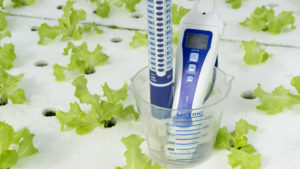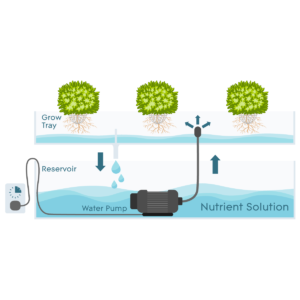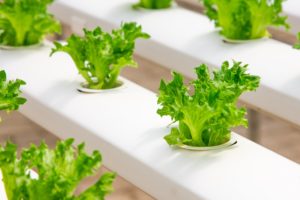Flood and Drain systems (Ebb and Flow) are precisely timed hydroponic systems wherein growers periodically flood their grow tray and allow nutrient solution to drain away. The flood cycle is timed to allow plants optimal nutrient intake. A Flood and Drain system fills several times daily. You may also see these systems referred to as Ebb and Flow systems. Timing ebb and flow cycles is one of the most important parts of a successful system.
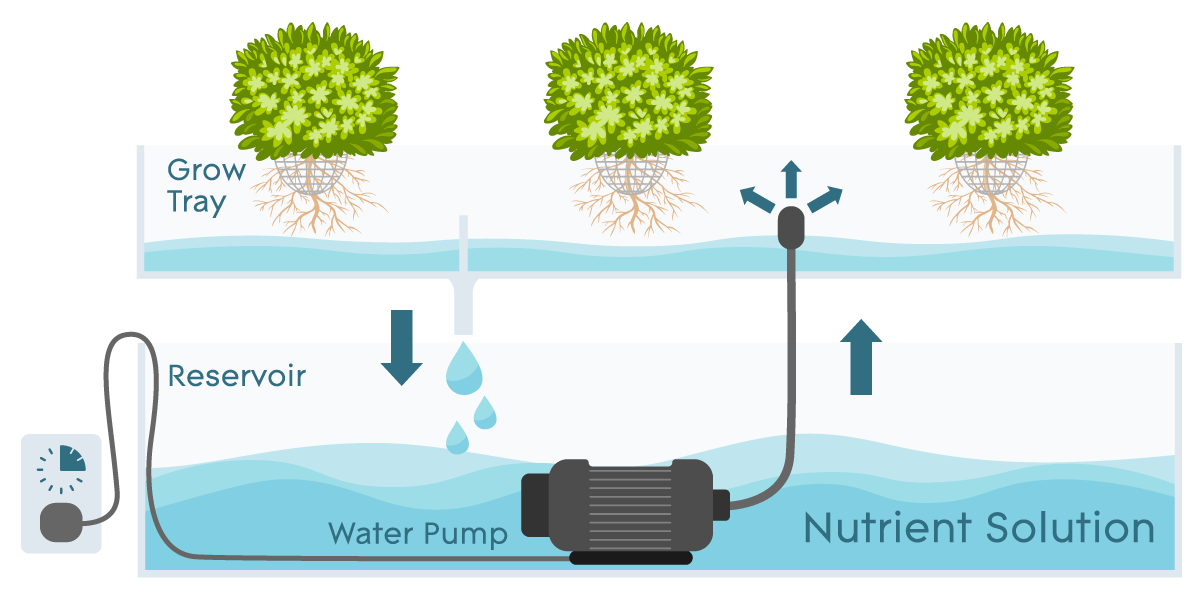
Like many other hydroponic systems, a flood and drain setup uses a pump, either an inline or submersible pump, to move water to the plants. The pump is connected to a timer, which initiates the flooding sequence. This interval wherein the system floods allows plants to take in nutrients. When the nutrient solution drains, roots are exposed to air, providing sufficient oxygenation.
Flood and drain systems typically use a growing medium to keep plants in place. This growing medium helps to retain a small amount of moisture. Growing medium for flood and drain systems should have a medium capacity to hold water at the most. It should also be very porous, and have high Air Filled Porosity (AFP).
The growing tray is deeper than in some hydroponic systems. In a flood and drain system, the tray is typically referred to as a flood tray or a flood table. An overflow or drain valve prevents water from getting too high and overflowing. An ebb and flow system is ideal for growing many different plants, and it’s a popular type of hydroponic system for simplicity and effectiveness.
With a flood and drain system, plants get sufficient nutrient solution, and plenty of oxygen, which keeps roots healthy.
Timing Ebb and Flow Cycles
Not every flood cycle works the same way. There are several factors unique to your hydroponic system that determine how and when flooding takes place. The ambient conditions in your grow room factor in, as do the size and needs of your plants. Your growing medium and overall water needs also play a part. For example, a growing medium like clay pebbles that doesn’t hold a lot of water means you need to flood more often. If you use something like vermiculite, which holds more moisture, you don’t need to flood as often.
No matter how often you need to flood,
a flood interval shouldn’t be longer than 10 to 15 minutes
Make sure you’re not flooding your system if your plants haven’t used the remaining water in their grow trays. This can be serious overkill, and it’s no good for your plants either. The points between ebb flow cycles allow plants to use nutrient solution left behind. Too much water, and it’s hard to make sure your plants can ‘breathe.’
That can also mean you need to do some ‘guess and check’ work before setting a timed schedule.
Some systems only need to be flooded a few times a day. For grow rooms that tend to be dry and hot, with larger plants, you may need to flood many times daily, even between 10 and 15 times. However, that isn’t typical of most ebb and flow systems.
The best way to figure out flood cycles is by timing it yourself.
Once you have your flood and drain system set up, get your stopwatch out. Or rather, just use the timer on your smartphone. Turn your pump on and start timing. Watch carefully as the flood table fills. Once the water level reaches about 80% of the tray, stop the timer and turn off the pump.
Now, you have a good starting point for determining how long each flood cycle will last. If it takes more than 10 to 15 minutes to fill your flood tray, you may need a more powerful pump. You can also move your pump and reservoir closer to your plants to reduce the power lost in moving water over longer distances.
We recommend this digital ebb and flow timer:
Growing medium for ebb and flow systems
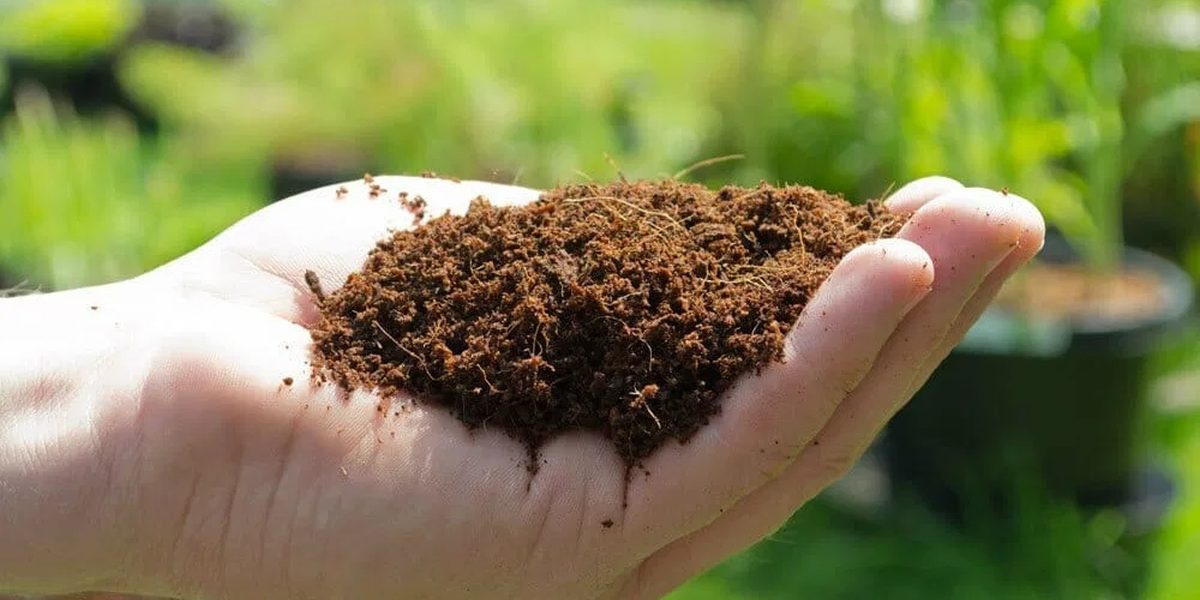
It’s easier to figure out flood intervals if you use a growth medium that’s more common for flood and drain systems.
The most popular flood and drain growth mediums include:
- Rockwool
- Clay pebbles (also called Hydroton)
- Coco Coir (often mixed with 50% perlite)
Note: Most flood and drain systems do not need to be flooded in their ‘night period.’ Basically, most of the time you’ll flood only when the lights are on.
Rockwool – holds moisture better and doesn’t need to be flooded as often. In fact, you may only need to flood a system with rockwool once daily. If the rockwool dries out faster, you may flood up to once every three hours.
Clay pebbles – these are a ‘hard’ type of growing medium. They drain out much quicker than others. Because of this, you’ll typically flood your system every two to four hours. This means you may have up to eight floods per day, or as little as four.
Coco Coir – this growth medium has a moderate moisture retention. Flooding is best done every three to five hours. Typically, systems with coco coir are flooded three to five times daily.
Max flood height for timing cycles
Maximum flood height is one of the most important things to figure out when you’re using an ebb and flow system. What is max flood height? It’s the highest level the water should reach when you flood your system. Timing ebb and flow cycles can depend on the depth of your tray. A shallow system takes much less time to fill. However, you’ll have to flood it more often, since it dries out faster too. A deep flood tray takes longer to fill, but it also takes longer to dry out.
Ideally, your flood tray should be filled to about 80%, or ¾ of total height. The overflow tube is usually placed near the top of the growing medium. However, to ensure your system drains properly, it’s best to put it a few inches lower.
Note: flooding your tray to a water level higher than 75-80% can displace plants, and cause overflow when water can’t drain quickly enough.
Pumps for ebb and flow systems
Your pump’s power plays a large part in determining how quickly your flood tray fills too. Not only that, most pumps are rated to pump to a certain height. This height is called the head or the head height. Then, the pump is rated by how much water volume it can move. Most pumps are rated by GPH, or Gallons per Hour.
So, how can you figure out what size pump you need for an ebb and flow system?
Different types of hydroponic systems have different factors you need to consider when sizing your submersible pump. Ebb and flow systems need special considerations too.
Learn about pumps for hydroponics here:
First, you need to figure out your ideal flow rate.
When we talk about flow rate, we’re basically talking about Gallons per Hour (GPH).
For flood and drain systems, there’s an equation to help you calculate optimal flow rates:
Flood tray volume (in gallons) x hourly flood rate = flow rate
Next, measure the distance between the level you want water to rise to in your flood tray, and your reservoir. This is commonly called ‘head height.’
When selecting a submersible pump, read carefully through the manufacturer’s specifications. Most pumps come with a GPH rating, and a chart that shows how GPH will decrease as water is moved to certain heights.
If in doubt, get a bigger pump, or one with adjustable flow rates. Many hydroponic growers prefer to get pumps that are about twice as big as they need. If you don’t want to double your pump size (and it’s certainly not required), go for a slightly larger pump. This gives you a little wiggle room when you’re setting up your flood tray.
Here’s an example so you can see how to put this information together:
Let’s say your flood tray holds 3 gallons. And let’s assume you need to flood your tray every 3 hours. Since you won’t have an ‘hourly’ flooding, just use some simple division to get your figure. In this case, 1 hour / 3 = .33
Plugging these numbers into the equation from above:
3 (gallons) x .33 = .99
We can simplify this and just say 1 gallon. Therefore, the flow rate should be 1 GPH.
Of course, this is a really simple example, but you can just plug your measurements into the equation.
In this case, you would need a pump with at least a 1 GPH flow rate. However, because velocity is lost when water flows upward, chances are you’d need a more powerful pump.
How to tell if your flood intervals are right
Now that you have everything set up, and more or less functioning, you need to check your work. Timing ebb and flow cycles can take some figuring out. If plants are wilting in between flood cycles, you need to decrease the amount of time between ‘feedings.’ Short of that, you’ll need to look at other things to see if your feeding schedule is correct.
Take a look at your growing medium. It needs time to dry out a bit between flooding, and your plants should be able to use the nutrient solution left behind after your table drains. If you see very wet growing medium as you’re about to begin the next flooding, you’re feeding your plants too often.
On the other hand, if the growing medium is bone dry between flood cycles, you need to feed plants more often. Or, if your plants are looking droopy but noticeably ‘perk up’ after the flood table is filled, they need more frequent floods.
Ideally, you should be able to start your first feeding around ½ hour after you turn the lights on. If your plants look parched before that, look at your ambient conditions. Sometimes large, very thirsty plants can benefit from an overnight feeding, if it’s really warm and dry in the grow room.
Don’t worry if you struggle to find the optimal cycles at first. Flood and drain systems need to be adjusted to find a perfect feeding schedule. And don’t forget: plants’ needs change over time. That means your feeding intervals will too.
Frequently asked questions
What plants can I grow in an ebb flow system?
Most plants do quite well in an ebb and flow system. The growing medium is ideal for supporting heavier plants, which makes it one of the most versatile systems in hydroponics. Greens and herbs are easy crops to grow in this system, although tomatoes and beans are also favorites.
How often to change water in flood and drain systems?
You can follow typical rules for hydroponics water changes. You’ll need to add water to your reservoir as it evaporates, typically daily or every other day. Then, do a full water change around every two weeks, or when your top off amounts reach the full volume of your reservoir.
Should I add nutrients to my hydroponics system every time I add water?
Even if you use a different system, the rules for adding nutrients remain the same. Do not add nutrients every time you add water. This can cause nutrient solution to become much too saturated, which can hurt your plants. Add nutrients into your system when you do a full water change. Test EC frequently, and if you fall out of your target range, you can add extra nutrients. Remember, always test EC after adding any nutrients to your tank.

